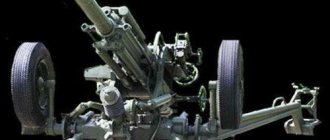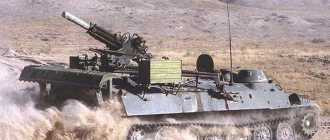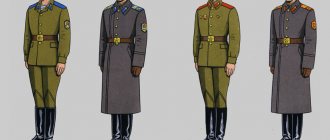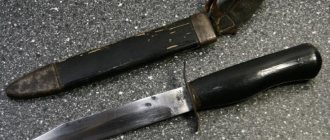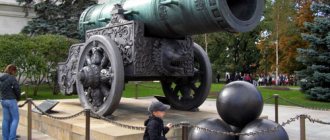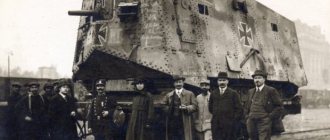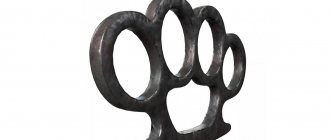The history of the creation of the 50-mm company mortar of the 1938 model.
In general, the idea of making infantry more “toothy” has never abandoned weapons designers. However, even the smallest artillery piece attached to an infantry unit immediately deprives it of mobility. With the advent of rifle grenade launchers during the First World War, the problem seemed to be solved, but this solution turned out to be only temporary. The fact is that the models available to the troops (for example, the Dyakonov grenade launcher) were purely “positional” weapons. It was still possible to shoot more or less accurately from it while in cover and firing at a stationary target, but it was no longer possible to conduct more or less accurate fire under conditions of an offensive, and even at an enemy who had taken up active defense. . But the caliber of rifle grenade launchers (usually about 40 mm) was too small for shooting over areas and required exceptional accuracy.
In such conditions, in 1936, in the design bureau of plant No. 7, work began on the same compact and mobile, but more accurate and powerful grenade launcher system for infantrymen, which became a small smooth-bore 50-mm mortar, originally called “Osa”.
The main designer of the mortar was B.I. Shavyrin, and the weapon itself was implemented according to the so-called. diagram of an imaginary triangle, when the two sides of the triangle are the trunk and the biped-carriage, and the third side is an imaginary line running along the ground between the support points of the barrel and the biped-carriage.
The new 50-mm mortar was intended for direct fire support of the actions of a rifle company, destruction or suppression of enemy fire weapons and manpower, located both openly and on reverse slopes of heights and in shelters. Due to its relatively low weight (12 kg), a mortar of this type can be carried on the battlefield by just one person, and during the campaign, three mortars were packed and transported in a special mortar cart mod. 1938 (MP-38) .
A man's pack was also developed, which made it possible to carry a mortar during a campaign on the back of one of the mortar crew numbers.
After short tests, the mortar was put into service under the name 50-mm company mortar model 1938 and put into mass production.
However, during the operation of the weapon, a number of shortcomings were identified, some of which were almost fatal for the new weapon:
- Despite the relatively small weight, the 50-mm company mortar of 1938 still weighed quite a bit. The “machine” also had rather large dimensions, making camouflage difficult, and in addition, with each shot it unmasked itself, raising a substantial column of dust into the air.
- The mounting device for the sight and remote tap is too complicated. In addition, the sight became confused every time the rotating mechanism was operated, and the rotating mechanism itself quickly became dirty and moved with difficulty.
- The minimum firing range of the mortar was 200 meters. That's a lot for a company mortar!
Soviet 50-mm company mortar, model 1938.
Lesson notes for the class “Mortars of the USSR and the Russian Federation”
Silent mortar 2B25 2011
The 2B25 silent mortar created by the Burevestnik Central Research Institute for special forces was presented by Russia at the international exhibition of weapons and military equipment MILEX-2011 in Minsk.
The purpose of the 2B25 mortar is to defeat the enemy wearing personal armor protection, located openly and in uncovered field-type shelters (in other words, trenches and trenches). The design of the mortar allows firing at both observed and unobserved targets from closed firing positions from soils of varying hardness at any time of the year and day. Moreover, it is almost impossible to detect the place from which the shooting is taking place - when firing, the mortar does not create either smoke or noise. The main feature of the 2B25 mortar is maximum secrecy in combat use, which is achieved due to the design of the shot. When fired, the powder gases are locked in the shank of the mine, so no smoke, no sound, no flame, no shock wave is created. The sound of a shot is no more audible than when firing from a Kalashnikov assault rifle with a silencer.
A similar silent scheme was already used in the USSR in 1983 in the PSS pistol (Special Self-Loading Pistol), where the powder gases were also locked in the cartridge case when fired. And in the 60s in the USSR, the secret silent grenade launcher “Izdeliye D”, built according to a similar design, entered service with special forces. But in general, such weapons are very rare. A similar product is only available in France, but their grenade launcher is inferior to the 2B25 mortar in terms of firing range and warhead weight. The 2B25 mortar is capable of hitting targets at a distance of 100 to 1200 meters. Its rate of fire is 15 rounds per minute, its weight is no more than 13 kilograms, and the weight of the warhead is 1.9 kilograms.
The 2B25 mortar is distinguished by its ability to fire at observed and unobserved targets from closed positions, from soils of varying hardness at any time of the year and day. Thanks to its mobility, noiselessness, flamelessness and smokelessness, it can be used to surprise the enemy.
| Performance characteristics | 2B25 |
| Maximum firing range, mm | 1200 |
| Minimum firing range, m | 100 |
| Vertical guidance angle, degrees. | 45-85 |
| Horizontal guidance angle without reinstalling the biped, degrees. | ±4 |
| Horizontal guidance angle with biped reinstallation, degrees. | 360 |
| Mortar weight, kg | 13 |
| Rate of fire, rds/min | 15 |
| Calculation, man | 2 |
2B9 (2B9M) “Cornflower”
Soviet transportable, towable and self-propelled automatic smoothbore mortar of 82 mm caliber. Development began on the basis of ideas and under the leadership of chief designer V.K. Filippov in 1946 - initially as a casemate weapon for fortified areas.
In 1955, the system entered service with the Soviet Army under the designation KAM (“Casemate Automatic Mortar”). In 1954, work began on creating an automatic mortar based on KAM on a field carriage. In 1959, such a mortar (F-82) successfully completed field tests and was recommended for adoption, but it was not accepted for service and work on it was stopped. The development of a field automatic mortar for the Soviet Army resumed only in 1967. In 1970, the modified F-82 under the designation 2B9 “Vasilyok” was put into service and the following year, 1971, it was put into mass production. After several years of mass production, the mortar was modernized by replacing the water-cooled barrel with air cooling. The modified mortar received the designation 2B9M and is in service and in mass production until the present (mid-2017) time.
Characteristics of the 2K21 system with the 2B9M mortar
- Caliber, mm: 82
- Vertical guidance angles, degrees: from −1° to +78° (firing line height 670 mm) or from +7° to +85° (firing line height 970 mm)
- Horizontal guidance angles: ±30°
- Weight in firing position, kg: 632
- Weight of transport vehicle 2F54, kg: 3930
- Weight of the entire system in stowed position (with ammunition and crew), kg: 6060
- Calculation, people: 4
- Maximum technical rate of fire, rds/min: 170
- Maximum practical rate of fire, rds/min: 100—120
- Maximum weight of the mine used, kg: 4.6 (mine A-832)
- Maximum initial mine speed, m/s: 272
- Minimum mounted firing range of the O-832DU mine, m: 800
- Maximum firing range of the O-832DU mine, m: 4270
- Radius of continuous damage, m (mine O-832DU): 6
- Radius of actual damage, m (mine O-832DU): 18
50-mm company mortar model 1940
In 1940, the company 50-mm mortar was significantly improved under the leadership of V.I. Shamarin, who actually created a completely new weapon based on an earlier model. In the same year, the new mortar was adopted into service as the 50-mm company mortar of the 1940 model.
While maintaining the general design scheme and principle of operation of the mortar mod. 1938, the design of this mortar took into account the experience of producing 50-mm mortars and using them in the army.
In connection with the cases of burns of crew numbers by powder gases escaping from a remote valve, the mortar plate was equipped with a visor that protected the crew from dust and hot gases. The plate itself was made using a high-tech deep stamping method.
The design of the remote crane has been significantly simplified. Its length became smaller, which made it possible to reduce the dimensions of the entire mortar. Due to the release of more powder gases when the valve is fully open, the shortest firing range was reduced to 60 m.
The design of the biped carriage was also changed towards simplification. Now it was made from sheet steel using cold stamping.
In general, the mortar mod. 1940 differs from the fragmentation mortar mod. 1938 with much lighter weight (9 kg), better manufacturability and greater ease of use. Of the total number of mortars supplied to the Red Army by industry for the period from January 1, 1939 to June 22, 1941, 40 thousand, company mortars of 50-mm caliber accounted for 24 thousand.
These were mainly mortars of the 1940 model.
Work at the position
Having taken up the firing position (OP), the mortar crew installed the base plate on the ground so that it had a slight slope forward. If necessary, the desired position was achieved by leveling the soil with a spatula. Guided by the white stripe marked on the table and moving the base plate, the 5 cm l Gr W 36 mortar was roughly aimed at the target. The turning mechanism should be in the middle position.
By striking the handle of the shovel, the base plate was pushed down until the ribs on the underside sank into the ground.
The mortar is leveled by rotating the 8 handles until the level bubble is in the middle position.
Characteristics of the 50-mm company mortar mod. 1940
A country:USSRType:Company mortarDate of issue:1940Calculation:2 peopleCaliber:50 mmLength:780 mm (barrel length 553 mm)Width:No informationWeight:9 kgRate of fire:30 shots/min.Firing distance:up to 800 mInitial projectile speed:97 m/sAmmunition:Transportable. 50 mm feathered mine weighing 0.85 kg
The characteristics are given for a 50-mm mortar of the 1940 model.
Brief description of the design
The German 50-mm mortar (5 cm l Gr W 36) consists of 2 main components:
- base plate, with leveling mechanisms and horizontal rotation mechanism;
- barrel with a lifting mechanism installed on it.
The purpose of the lifting mechanism is to aim at a target in a vertical plane. For rough guidance, it is necessary to recess the latch 7 and move the sleeve 5 along the tube 4. Precise guidance is carried out by rotating the turnbuckle 6 connecting both of its parts. The rotating mechanism is designed for precise horizontal guidance, which is achieved by rotating the handle 3.
Leveling the mortar in place (horizontalization) is achieved by rotating the 8 handles located on both sides of the barrel.
The 5 cm l GrW 36 mortar is equipped with a firing device. To fire a shot, you need to lower the mine into the table, and then press the trigger of the firing device.
The mortar crew consisted of three people - a commander, a gunner and a loader. In the marching position, the mortar was carried disassembled, in two packs. The first pack is a barrel, with a vertical guidance mechanism, the second is a base plate.
For short distances, as on the battlefield, the 50-mm mortar was carried assembled, holding it by the handle. Usually, in addition to the mortar itself, the crew also carried five trays of mines, ten pieces per tray, as well as a box of accessories.
The ammunition load of the 5 cm l GrW 36 mortar included a single 910-g cast iron mine. The mine consists of three parts:
- a body containing a TNT charge weighing 115 g;
- stabilizer with tail cartridge inside;
The fuse does not require any settings before firing.
